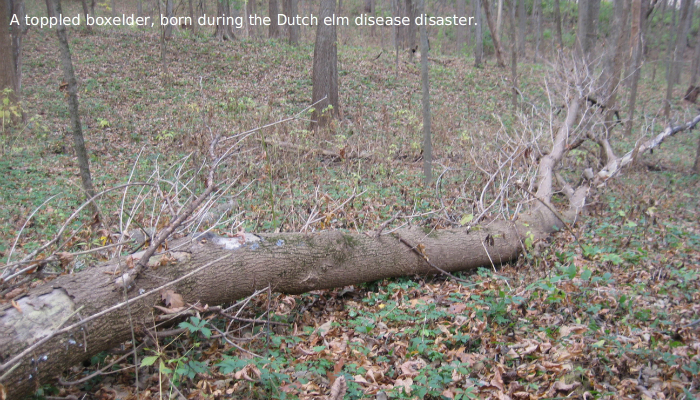What Good is Boxelder?

By Lon Drake
Our native boxelder doesn’t get much respect, even from conservationists. But it’s a fast-growing, sun-loving pioneer, and in the late 1960s and early 1970s, Dutch elm disease ran rampant through our woodlot and killed nearly half of the upper canopy. The new sunny spots quickly turned into a jungle of brambles and ragweed, and within another year or two little boxelders came poking up through the tangle. But they had competition. The remaining canopy trees sprawled their high branches out into the light gaps, and many shade-tolerant hackberry saplings were already on standby, just waiting for such a disaster. The canopy closed rapidly, the brambles are now long gone, and today only a couple living boxelders remain in the 7-acre woodlot – along with a liberal scattering of snags and downed logs still remaining to show that the boxelder had its moment in the sun.
So what good is boxelder? Let me tell you. In a more permanently sunny location, it might live 50-100 years, becoming a more respectable tree. Being in the maple family, it can be tapped and its sap produces a tasty pale syrup – if you don’t scorch it. It keeps its abundant seeds aloft a long time, and the evening grosbeak is especially fond of them. So much so that their occasional irruptions that visit us, are often attributed to boxelder crop failures elsewhere. Chipmunks, squirrels, quail, turkeys, and other natives also make good use of the seed. And when boxelders go hollow, they become wildlife housing.
Going westward up the many drainages of the Missouri River, most of the tree species of our local woodlands steadily drop out. Then the boxelder and several cottonwoods come into their own, growing to a large size along the waterways, tolerant of the glaring sun and harsh climate, and providing welcome shade, shelter, nesting, food, wood, and other basic needs for many critters, including us.
But what about the boxelder bug? It is true that the adult bugs will move into your walls in autumn to hibernate, intending to revive next spring and seek out boxelder trees to lay their eggs, so the next generation can suck sap to help their growth. Folklore says that keeping the trees a long way from your house will keep the bugs out, but I’ve tried that and it doesn’t seem to help much. In a buggy year, I seem to have as many as anyone else.
So if you have an acreage, or manage a property, cut some slack for the boxelder if you can. Every native species seems to have a role in the ecosystem, and boxelder is no exception.
In the photo, the downed boxelder had its last leaf in 2014 and toppled in 2016. Note the many little branches along the trunk, a last-ditch effort to grab some sunshine. A slice through the lower trunk revealed early annual rings more than 4 rings per inch – while the outer inch of growth contained about 15 rings.


